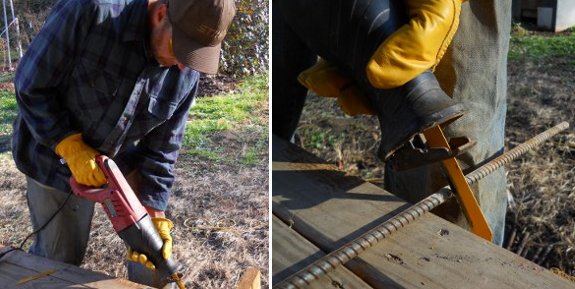
Quick hoop rebar stakes

One casualty in the barn
organization project this past summer was the quick
hoop stakes. I looked and
looked and can't seem to find where I put them.
It's not easy cutting through
rebar with a reciprocating
saw. Anna holds down one
end while I operate the saw. Expect to need a fresh blade after only 7
to 10 cuts. I was able to stretch that number when I figured out you
can just cut less than half way through and then break it off.
Hopefully this post will
remind me to store these rebar stakes in a more obvious spot when we
put them away in the Spring.
Want more in-depth information? Browse through our books.
Or explore more posts by date or by subject.
About us: Anna Hess and Mark Hamilton spent over a decade living self-sufficiently in the mountains of Virginia before moving north to start over from scratch in the foothills of Ohio. They've experimented with permaculture, no-till gardening, trailersteading, home-based microbusinesses and much more, writing about their adventures in both blogs and books.
Want to be notified when new comments are posted on this page? Click on the RSS button after you add a comment to subscribe to the comment feed, or simply check the box beside "email replies to me" while writing your comment.

I have "a thing" for rebar. We buy it by the ton.
I use a metal chop saw for cutting large volumes (the wheel can easily handle 3-4 pieces at a time depending on gauge.
I use a angle grinder when I need to cut in very awkward locations like on top of a dome made of rebar.
My favorite tool of all is a hand held, hand powered, hydraulic cutter. It's good for up to 1/2" and is totally silent, light and does not require any sort of electrical power.
http://blog.holyscraphotsprings.com/2009/02/hydraulic-cutters-test-originally.html
Errol-I think that would have been easier, our angle grinding wheel is on its last leg and I'm not sure where I "stored" the new one I bought last year.
Phil-I agree that a metal blade for the chop saw would be the more long term solution, and I might do that for future rebar projects. We're just getting started in the world of rebar fabrication.
bob-Thanks for the tip on the Metabo, sounds like you've had a lot of experience with this subject. Makes sense how slowing a grinder down could help with different tasks. Makes me wonder if an item at Harbor Freight called a "Router Speed Control" would work at providing control over slowing down an AC driven motor in a grinder? Might be cheaper than the Metabo?
Roland-We thought about making some sort of wooden jig holder, and someday I want to get a large table vise, but we really wanted to get the quick hoops up that day and decided it would go faster with Anna holding and repositioning even though the vibrations were a bit uncomfortable.
Marco-Thanks for mentioning that. A lesson I first learned on the chainsaw which translates to many cutting device. I'll have to try a round of dipping the blade in water after each cut to see if that extends the amount of cuts we could get per blade.
Mikey Sklar-That hydraulic cutter looks like it would be handy to have on jobs where power is a challenge. It brings up all kinds of questions like is the cutting blade replaceable? and does cutting rebar take a bite out of the metal cutting surface like sometimes happens with cheap bolt cutters?
When sawing, milling or turning metals, it is usually a good idea to use cutting fluid.
A piece of 2x4 with a small notch sawed into it would enable you to pin the rebar to the deck under it by putting your foot onto it.
WRT hydraulic cutters, most of these have replacable blades. Given the extreme pressures that hydraulics can generate, they use completely different materials from bolt cutters.
A lot of household tools use universal motors (if the motor has brushes and a commutator it is probably a universal motor). So if the speed control works for a router, there is a good change it works for a grinder. But if the motor isn't designed with variable speeds in mind, it might get cooling issues.